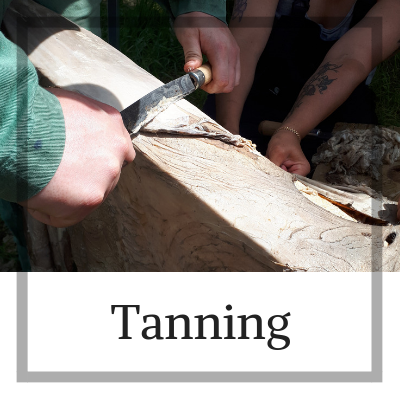
I am often asked if our Brain Tanning class can produce leathers like the ones used for carving, making shoes, or saddles. The quick answer is, No. But there’s more to it. The two materials are actually not alike in many ways, in both how they are made, and the end product.
Brain tanning produces buckskin. Buckskin can come from deer hides, moose hides, elk hides and many other animals. It is a soft, pliable material that does not harden or stiffen up when exposed to water. Buckskins are the original Chamois.
Leather tends to be a more rigid material, however softer pliable leathers are used for many different things.
However, the main difference is how they are made.
Leather making and brain tanning share many steps. Those steps include fleshing and graining the hide so nothing is left but the middle layer of skin. However...then it all gets quite different.
In brain tanning, we remove the mucous that coats the fibers of the skin, then we reintroduce oils and stretch the hide until it is dry and pliable. Then the hide is smoked. The smoke and oils together coat the skin fibers and create a water barrier between the fiber itself and the outside environment. This prevents rotting and keeps the hide from turning stiff like cardboard.
Making leather is a different chemical process all together. Steps that are seen in the leather making process beyond fleshing and graining are;
Pickling
Degreasing
Tanning (which is a step in making buckskin also) with chrome, vegetable sources of tannins, or aldehyde and oils.
Splitting
Shaving
Dying
Waxing
Leathers and brain tanned buck skin share some applications, such as making clothing or moccasins. However, leather can be used for a far greater variety of things.
Brain Tanning is a process that can easily be done at home with very natural materials. Making leather tends to require a far greater time investment, normally requires many solutions and chemicals to achieve the desired end result, and also tends to require specialized equipment (I say tends because it ultimately depends on the type of leather being created).
Despite these differences in how they can be created, leather and buckskin both make wonderful materials from renewable sources.
Being involved in the transition of a hide to buckskin is an amazing experience. It is a traditional skill that unites the cultures and peoples from around the world. It is a part of our common heritage as humans and is one of the critical skills that has helped cultures around the world thrive for thousands of year.
I am so honoured to be a part of stewarding this skill into the future. With so few left in North America who practice this once common place skill, it is a great blessing to see such interest in the Brain Tanning classes that we have hosted here in Alberta over the past year, and which we will be offering again in the coming year.
May this year see so many new stewards of this amazing skill.
http://www.reskilledlife.com/tanning-hides/
From my home fire to your, hai hai.

Congratulations, your post has been selected to be included in my weekly Sustainability Curation Digest for the Minnow Support Project.
Editor of the The State of Steem SoS Daily News.
Promoter of The State of Steem SoS Weekly Forums.
Editor of the weekly listing of steem radio shows, podcasts & social broadcasts.
Founder of the A Dollar A Day charitable giving project.
Hello @harvardhomestead! This is a friendly reminder that you have 3000 Partiko Points unclaimed in your Partiko account!
Partiko is a fast and beautiful mobile app for Steem, and it’s the most popular Steem mobile app out there! Download Partiko using the link below and login using SteemConnect to claim your 3000 Partiko points! You can easily convert them into Steem token!
https://partiko.app/referral/partiko
Congratulations @harvardhomestead! You received a personal award!
You can view your badges on your Steem Board and compare to others on the Steem Ranking
Vote for @Steemitboard as a witness to get one more award and increased upvotes!